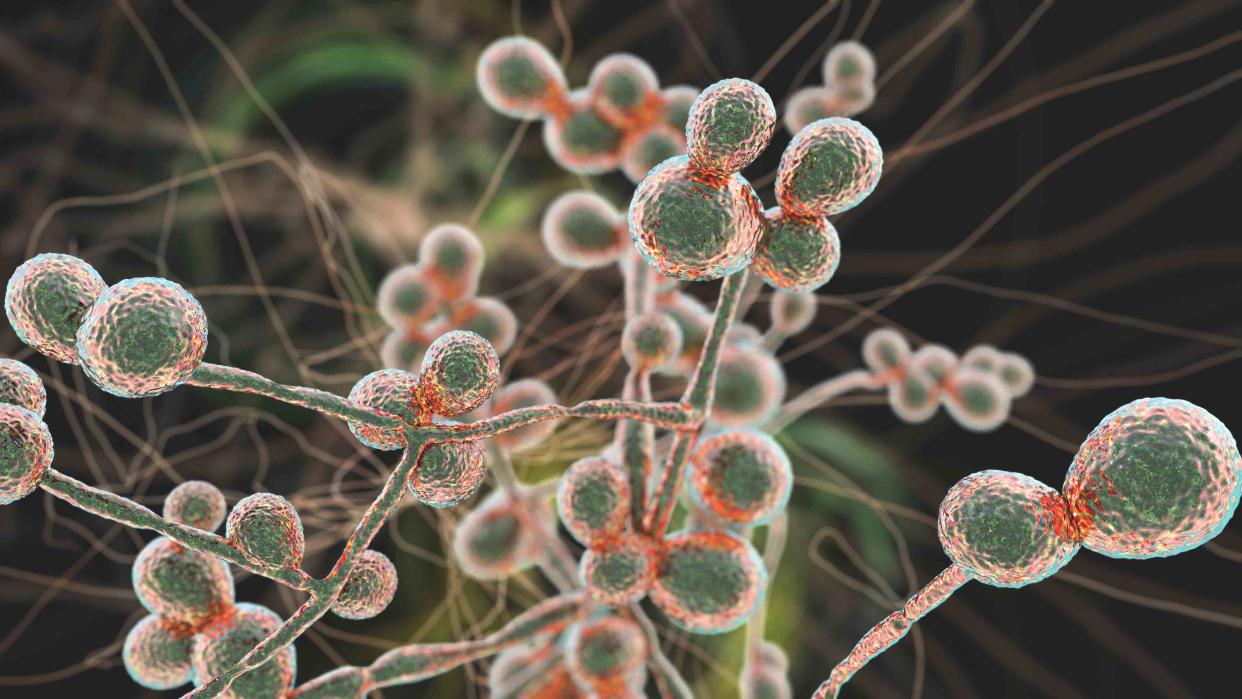How Candida Auris Is and Isn't Treated

Kateryna Kon / Science Photo Library / Getty Images
Candida auris infections are on the rise. Because some cases are resistant to antifungal medications, they can be challenging or impossible to treat.
The most common course of treatment for Candida auris infections right now is a mix of antifungal medications that target the fungal cell wall.
There’s plenty of misinformation online about treating or preventing Candida auris infections with over-the-counter drugs or by eliminating sugar, but experts say these methods are not effective and are dangerous.
Candida auris (C. auris) is making headlines lately as infections are appearing in clinical settings across the world, including in the U.S. While data is limited, the Centers for Disease Control and Prevention (CDC) reports that around 30-60% of patients infected with C. auris have died.
C. auris is a type of yeast—a family of fungus—that can live on the skin. It may not cause harm in relatively healthy people, but it can lead to a potentially lethal disease called candidiasis if it enters the bloodstream or lungs of higher-risk patients, like seniors and those with other underlying health conditions.
When that happens, it needs to be treated. The problem is C. auris can be drug-resistant.
How Candida Auris Is Treated
Mehreen Arshad, MBBS, an assistant professor at the Northwestern Feinberg School of Medicine and an attending physician in pediatric infectious diseases at the Ann and Robert H. Lurie Children's Hospital of Chicago, told Verywell that before someone is treated for C. auris, a physician has to determine whether the patient has an actual infection. C. auris can colonize a person without resulting in illness, especially if it's relegated to the skin.
"If you just had a routine test, and the fungus showed up on your test, that is not an indication for treatment," Arshad said. "But if the patient is actually sick, and the clinical symptoms are consistent with what you would think of with C. auris, then you typically start off with using at least two different antifungal medicines."
Related:What Are the Symptoms of a Candida Auris Infection?
Arshad explains that healthcare providers typically use two antifungals to increase the chance of effectively treating the infection while they wait for the lab report to determine what kind of particular fungus the patient is sick with.
"In case one [medication] doesn't work, the other one hopefully will," she said.
Mahmoud Ghannoum, PhD, a fungal disease expert and co-founder of microbiome company BIOHM, told Verywell that the drugs used to treat the fungus belong to a group of antifungal drugs called echinocandins.
There are three approved antifungals that belong to this class of drugs: caspofungin, micafungin and anidulafungin, he said. They work to kill the fungus and stop the infection from spreading.
"Echinocandins target the fungal cell wall (the outer layer that covers the fungus) where they inhibit an enzyme that is a critical component of the fungal cell wall," Ghannoum explained. "By inhibiting this enzyme, the wall of the fungus will break down, leading to cell death."
Some Candida Auris Infections Are Resistant to Drugs
If antifungal medications are not effective, Arshad said there’s a few options. To start, healthcare providers can increase the dose of the antifungals.
"But when you start to increase the dose, you're also increasing the toxic side effects," she said, such as rash, hypotension, bronchospasm, and angioedema.
The treatment approach depends on the location of the infection. If it’s in the brain, or in the fluid around the brain, for example, Arshad said healthcare providers might inject the medicine directly into that area.
Unfortunately, none of these methods are guaranteed to be successful.
Patients who are at higher risk of fatality from an infection include those who are immunocompromised, like cancer patients, transplant patients and diabetics, patients who are on multiple antibiotics for a longtime and patients who had recent surgery, Ghannoum said.
Experts say healthy people do not need to be overly alarmed about contracting C. auris.
Related:How to Prevent a Candida Auris Infection
How Not to Treat Candida Auris
Drugstore products, like topical antifungal treatments or yeast infection pills, won’t work on C. auris.
There is an abundance of misinformation online about C. auris, including on TikTok, where some users claim that you can treat or prevent it by cutting out sugar, or going on specific diets or cleanses.
Experts say you cannot treat a C. auris infection through dietary modifications, and medical attention is needed.
"I advise that people do not follow TikTok or other social media [advice] as the information there is not only inaccurate but could put immunocompromised patients at risk of death," Ghannoum said.
People might think that saltwater can help rid the fungus, since it can help kill some bacteria, but C. auris is highly resistant to saltwater, Arshad said.
"Washing everything with highly concentrated saltwater sometimes works with some organisms, but not the Candida auris because it's essentially a very hardy fungus that loves to stick to things," she said. "It's very difficult to get rid of it from the environment when it becomes part of the environment."
You can help prevent spread by engaging in good infection-prevention strategies like washing your hands. In clinical settings, healthcare providers should separate a patient with a C. auris infection from other patients to reduce the chance of spread, too.
"All of those infection-prevention strategies that we typically use still work," Arshad said.
Candida auris infections are first treated with a combination of antifungal medications that target the cell wall. Sometimes drugs are ineffective in treating the illness, so healthcare providers might increase the dose or turn to alternative methods.

